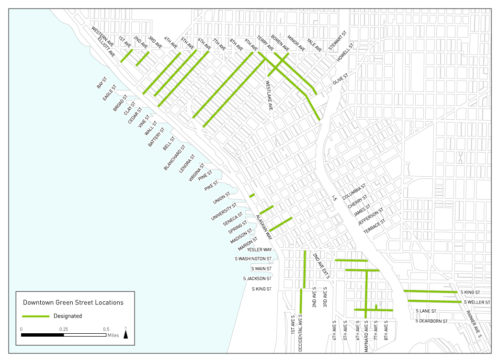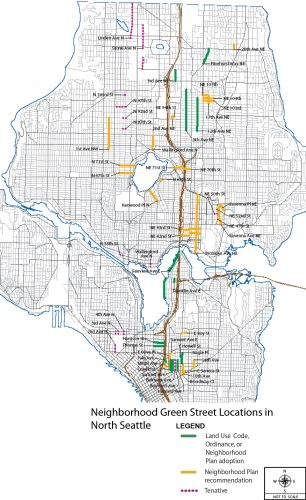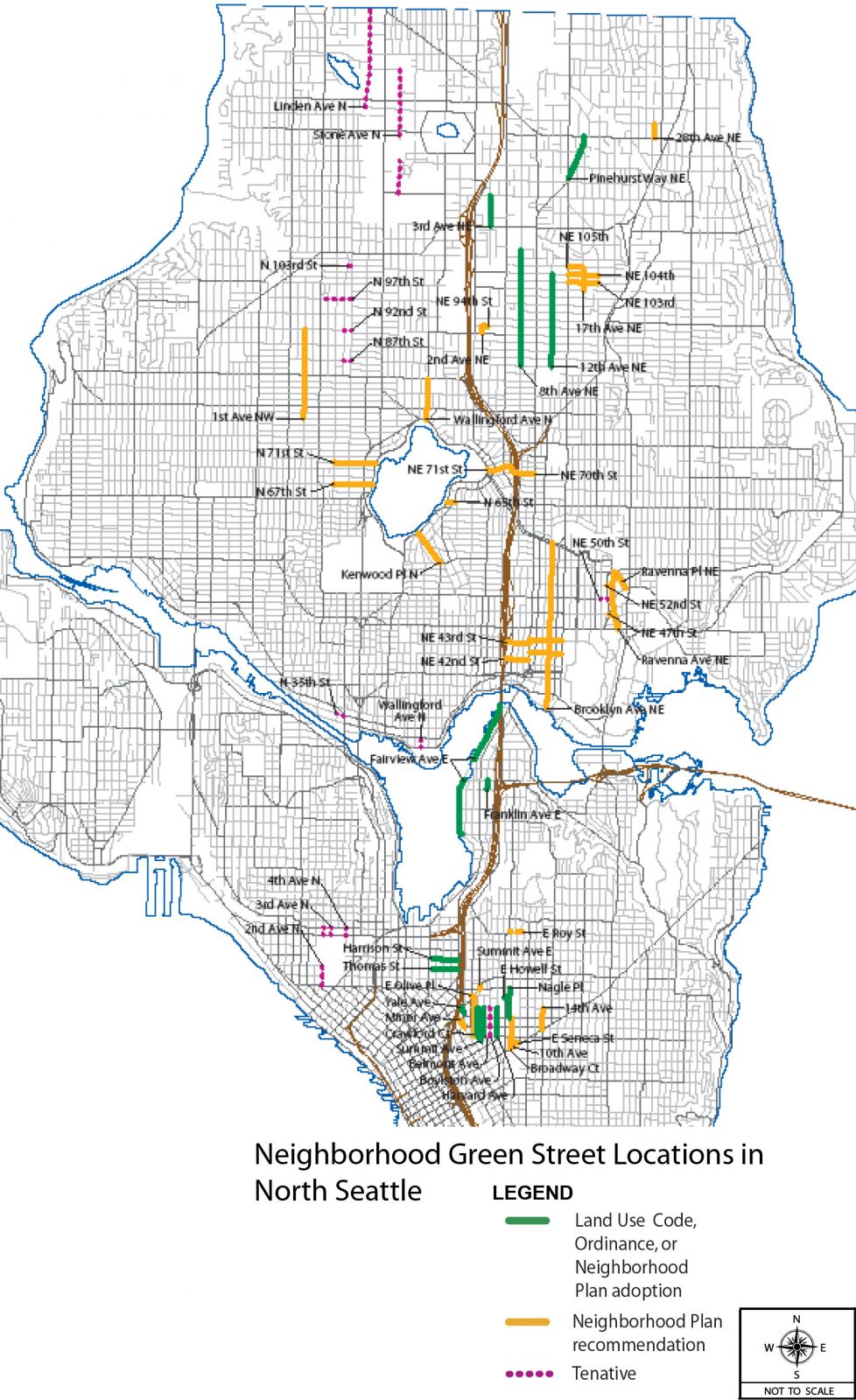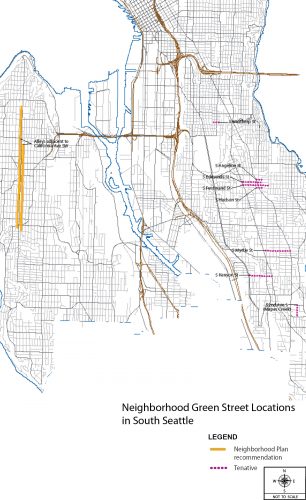5.4 Green Streets

A Green Street is a land use code designation and acts as an overlay to the street type assignment. Green Streets are designed to give priority to pedestrian circulation and open space over other transportation uses, but ensure emergency response for public safety is not adversely impacted. The treatments may include sidewalk widening, landscaping, traffic calming, and other pedestrian-oriented features. The purpose of a Green Street is to enhance and expand public open space, and to reinforce desired land use and transportation patterns on appropriate City street right-of-way.
The original designation and mapping of Green Streets is in the City of Seattle 1985 Land Use and Transportation Plan for Downtown Seattle. Additional mapping of Neighborhood Green Streets occurred in the Northgate Area Comprehensive Plan (City of Seattle, 1993) and in a number of Neighborhood Plans affecting areas throughout Seattle.
While the Seattle Comprehensive Plan contains the policy guidance for Green Streets, this Manual provides the design guidance and procedural information for an applicant who wishes to develop their project along a Green Street or Neighborhood Green Street. The information includes the planning and design process, the City approval process for Green Street and Neighborhood Green Street designs, and some information on construction and the maintenance of street features.
A key component of the design guidance relates to the classification of Street Types (refer to Street Classifications and Street Types) including Green Streets and Neighborhood Green Streets. For the types of street features that are appropriate to include on both Green Street types, refer to Street Classifications and Street Types. For information on the bonus floor area for amenity features allowed is described in SMC 23.49.013.
There are two types of Green Streets:
- Green Streets located in Downtown Seattle and defined and mapped in the Land Use Code; and
- Neighborhood Green Streets that are designated through neighborhood plans or other City adoption process (e.g., City Council Ordinance or Director’s Rule).
The City’s original Green Streets policy offered a developer bonus in exchange for construction of an approved Green Street streetscape, and the bonus was limited to Downtown Seattle, consisting of the Belltown, Denny Triangle, Urban Core, Denny Triangle, Pioneer Square, and International District neighborhoods (see Figure CM).
Subsequently, the City has allowed Green Streets to be designated in Neighborhood Plans outside of Downtown Seattle, where no funding incentive exists. These are referred to as Neighborhood Green Streets. A more complete description of each with the policy intent and purpose for follows:
Green Street Definition and Purpose
|
Definition |
As defined in the City of Seattle Comprehensive Plan Transportation Element, “Green Streets are designated on a number of non-arterial streets within Downtown Seattle. Landscaping, historic character elements, traffic calming, and other unique features distinguish Green Streets from other Street Types. Green Streets are designed to emphasize pedestrian amenities and landscaping in areas that have dense, residential land uses. Each Green Street has its own unique character and design. The street right-of-way dimensions can vary significantly from street to street and from segment to segment.” |
|
Purpose |
• Enhance pedestrian circulation and create open space opportunities in medium to high density residential areas lacking adequate public open space. • Create a vibrant pedestrian environment in the street right-of-way that attracts pedestrians. • Strengthen connections between residential enclaves and other Downtown amenities by improving the streetscape for pedestrians, bicycles and transit patrons. • Support economic activity in Downtown neighborhoods by creating an attractive and welcoming “front door” for pedestrians. • Maximize opportunities for trees and other landscaping to create a high quality open space. |
|
Location |
Designated streets in Downtown Seattle (refer to Figure CM). |
|
Typical Adjacent Land Use |
Residential or mixed use. |
|
Street Classification |
Non-arterial. |
|
Authority |
Designated by City Council Ordinance and adopted and mapped in the Land Use Code (SMC 23.49). |
|
Implementation |
The design and construction of Green Street improvements can be funded by developers in exchange for increased floor-area-ratio (FAR) or other land use code departures, as specified in Seattle’s Land Use Code (SMC 23.49.013). |
Neighborhood Green Streets
|
Definition |
As defined in the City of Seattle Comprehensive Plan Transportation Element, Neighborhood Green Streets may be on any non-arterial street – and in some cases low volume arterial streets – outside of Downtown Seattle. Similar to Green Streets, Neighborhood Green Streets emphasize pedestrian amenities, landscaping, historic character elements, traffic calming, and other unique features. Neighborhood Green Streets were designated in Seattle’s neighborhood plans. |
|
Purpose |
• Reflect a local community’s desire to target specific streetscapes for a pedestrian or open space enhancement. • Enhance the pedestrian environment and attract pedestrians. • Create open space opportunities in residential neighborhoods. • Retain unique street features (e.g., brick paving, mature landscaping that is adjacent to the roadway, curbless streets). |
|
Location |
Designated streets in neighborhoods outside of Downtown Seattle (refer to Figure CN: Neighborhood Green Street Locations in North Seattle and Figure CO: Neighborhood Green Street Locations in South Seattle). |
|
Typical Adjacent Land Use |
Residential or mixed use that includes residential uses. |
|
Street Classification |
Non-arterial. |
|
Authority |
Various. Neighborhood Green Streets are typically recommended in Neighborhood Plans or other transportation plans, and may subsequently be adopted into the Land Use Code through City Council Ordinance, designated by joint OPCD/SDCI/SDOT Director’s Rule, or included in a city recognized subarea transportation plan. |
|
Implementation |
Neighborhood Green Streets do not have a dedicated funding mechanism in most cases. Funding to design and build Neighborhood Green Streets may come from a Local Improvement District, Neighborhood Matching Funds, partnerships with other agencies (e.g., transit agencies), through private development or as part of a Seattle Public Utilities Natural Drainage Systems Project. |






